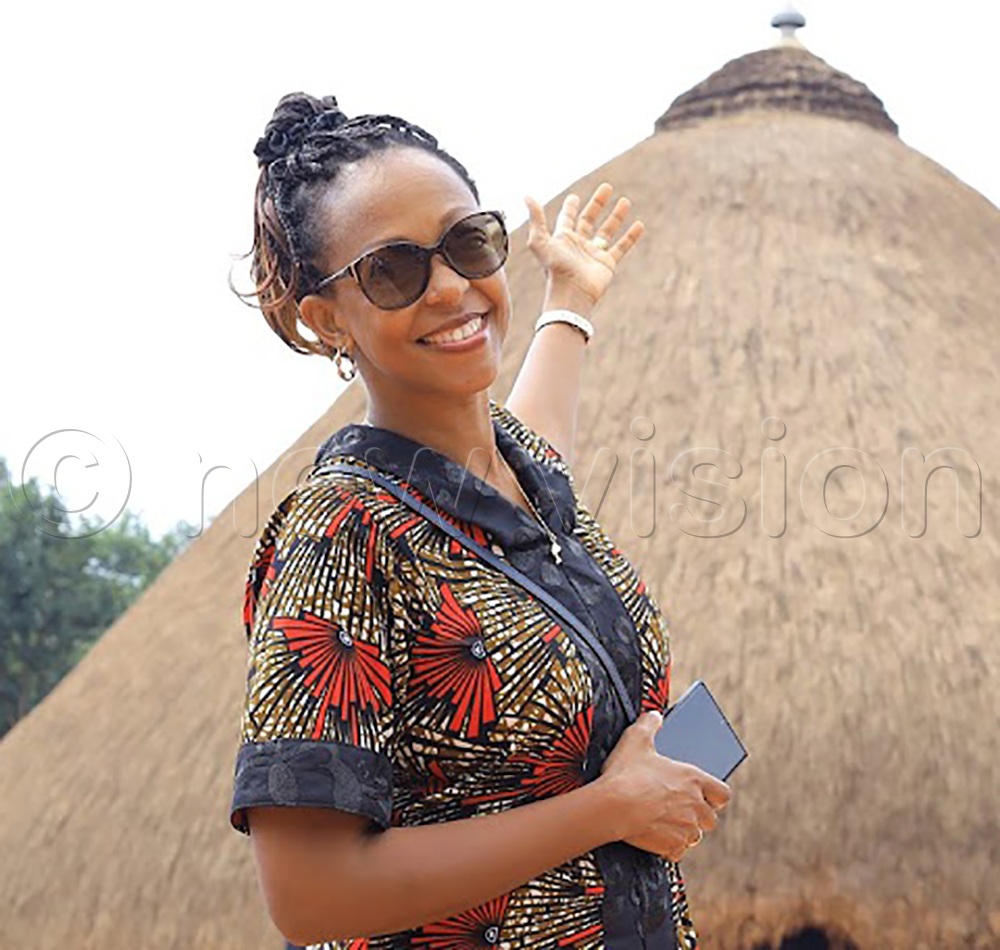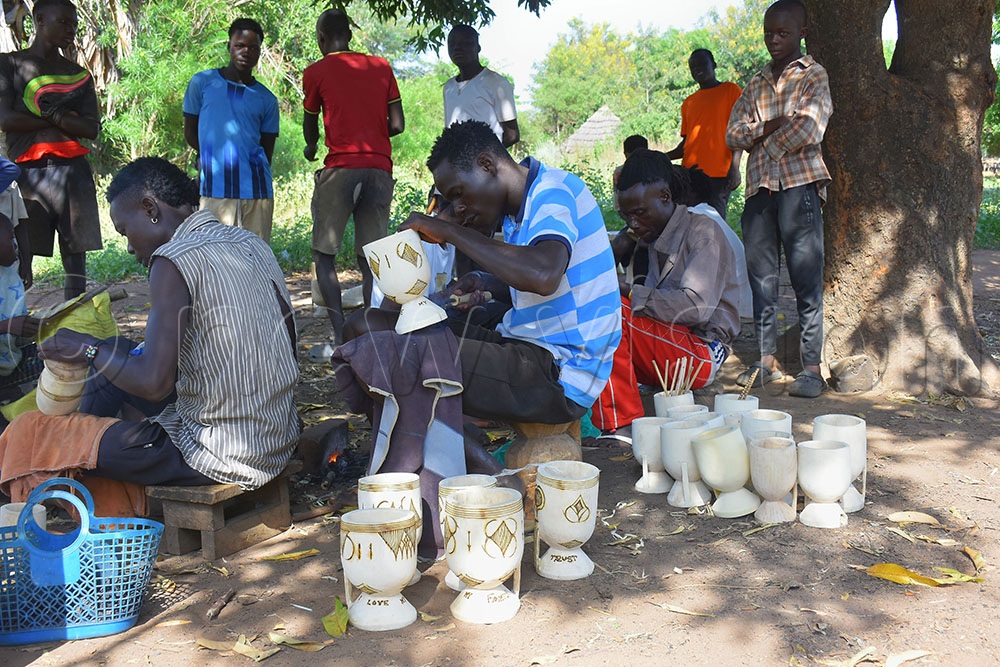How tourism supports artefacts industry in West Nile
Upon seeing a community engaged in art and craft making, the government established Pacer community polytechnic school in order to formalise the art of blacksmithing in the area.
The hand-made artefacts include wooden stools, tables, bows, arrows, utensils, musical instruments, plaques, plus several toys made in form and shapes of different wild animals that roam the area. (Credit: Julius Luwemba)
Juliana Kagwa, the UTB chief executive officer. The skill of making artefacts in the West Nile district of Pakwach is passed on from generation to generation. (Credit: Julius Luwemba)
Tucked in the northwestern corner of Uganda, the West Nile sub-region is a land of cultural vibrance and raw beauty.
Hemmed in by three international borders and bordered to the east by the Nile as it journeys northward from Lake Albert to South Sudan, West Nile carries the unique charm of an enclave that has long danced to its own rhythm. Integrated into Uganda as late as 1910, this isolated gem remains largely untouched, an authentic window into heritage.
Rich cultural mosaic
West Nile consists of 12 districts: Pakwach, Nebbi, Zombo, Madi-Okollo, Arua, Maracha, Terego, Adjumani, Obongi, Yumbe, Koboko, and Moyo. Its native ethnic groups—Alur, Lugbara, Kaka, and Madi- share deep cultural and trade ties with neighbouring communities in South Sudan and the Democratic Republic of Congo.
Since the departure of the Lord’s Resistance Army (LRA) rebels in 2005, the region has quietly blossomed again, revealing treasures of faith, folklore, landscapes, and resilience.
Untapped tourism potential
Though West Nile is among Uganda’s least visited regions, it boasts unmatched hospitality and a traditional charm, seen in everyday details like thatch-roofed homes.
The Uganda Tourism Board (UTB) recently initiated an eight-day media tour to spotlight the area’s rich natural and cultural assets—including pristine wildlife reserves and captivating indigenous experiences.
Community of creators
In Pacer Panyadwol village, Pakwach district, art isn’t just a pastime; it’s survival. Locals craft and sell artefacts as their primary economic activity.
From handmade stools, musical instruments, and utensils to lifelike toy animals carved from wood, these crafts embody the soul of West Nile, depicting all the wildlife that roams and thrives in the area.
Towns like Pacer Central and Jupalwala thrive on this trade, bolstered by proximity to tourist hubs like Murchison Falls National Park, Ajai wildlife reserve and East Madi wildlife reserve.
At 79, elder Melki Gidagi recalls a life of hunting and artistry. After hunting was outlawed, the community turned fully to crafting. “We’re proud to carry forward what our forefathers passed down,” he says.
Fellow artisan Martin Karlo, 72, sees tourists as crucial patrons. “They come for the wildlife, but leave with artefacts, too,” Karlo underscores the importance of tourism in the area.
Vocational education
Upon seeing a community engaged in art and craft making, the government established Pacer community polytechnic school in order to formalise the art of blacksmithing in the area.
However, Ismael Serubiri, the deputy instructor of the institute, said that most of the locals dropped out, claiming that what is taught does not suit their cultural way of blacksmithing.
"This institute was founded in 2002 with the intention of converting the place into a skills development centre. We added more courses such as building and concrete practice, motor vehicle mechanics, electrical installation, plumbing and pipe fitting, which the natives find exotic, hence dropping out," Serubiri intimated.
Steven Bithuchi concurred that indeed, he, among other fellow natives, dropped out of the vocational institute because it was not teaching the traditional art and science of making artefacts.
"All the artefacts we make do not have nails, and yet, the institute uses nails among other modern equipment. Whereas this is not a big challenge, we believe that the market likes our artefacts in their native raw format," Bithuchi expressed.
Christopher Otim, a leader in the area, explained that the natives are afraid of losing their knowledge and craftsmanship if they adopt other methods of making the artefacts. "If the government wishes to formalise this kind of work, they ought to assess it from within our locations and award certificates.
Alternatively, we can have a few of our elders co-opted among the teaching staff in the vocational institutes so as to ably pass on the knowledge to those undertaking formal education," Otim argued.
The crafts remain an important component of tourism in this region, as they are sold to tourists, especially those who visit Murchison Falls Conservation Area.
Whereas made with rudimentary tools, each item is produced with much skill, not taught anywhere in a formal school, but rather passed on in the lineage of the subsisting ethnic groups of the natives. Each item has a story and cultural significance as it transcends into economic value.
It remains to be computed how much each household earns from the crafts, but most families claim to be living off the skills and products made, albeit not enough money to sustain all their life's necessities.
Spotlight on West Nile treasures
Dr. Simplicious Gessa, the UTB spokesperson, noted that the West Nile region remains a virgin place with a lot of endowments to explore. "UTB is coming out strongly to market the raw culture of West Nile, including all their native skills, stories, cuisines, among several other products," Gessa stated.
According to the UTB spokesperson, this is part of the reason why this year's tourism day celebrations (September 27) was held in Arua, one of the cities in the West Nile region.
Juliana Kagwa, the UTB chief executive officer, emphasised that the government agency is committed to drumming up business for the West Nile region, as another way of diversifying Uganda's tourism products and endowments.
"As stated in our national tourism marketing strategy, UTB is going to continue promoting the entire region in addition to our other tourism products. We shall be telling our own stories, surpassing the scars and turmoil that this region has ever faced," Kagwa assured.